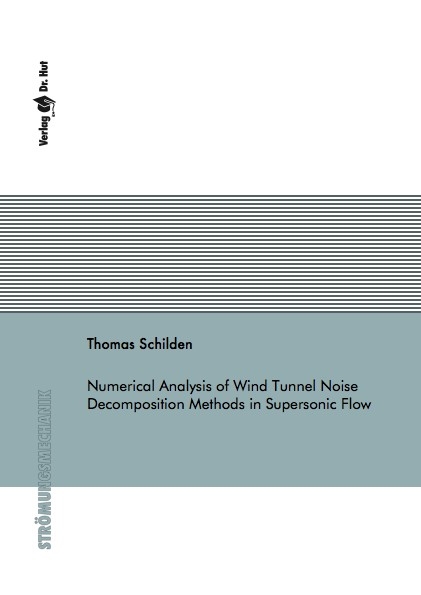
Numerical Analysis of Wind Tunnel Noise Decomposition Methods in Supersonic Flow
Seiten
2019
Dr. Hut (Verlag)
978-3-8439-3960-7 (ISBN)
Dr. Hut (Verlag)
978-3-8439-3960-7 (ISBN)
- Keine Verlagsinformationen verfügbar
- Artikel merken
The state of a boundary layer, i.e., it can be laminar, transitional, or turbulent, is a decisive factor for the convective heating of spacecraft. Therefore, the onset of transition defines an essential design parameter.
Since experimental wind tunnel data of boundary layer transition are affected by tunnel noise, i.e., perturbations of the freestream, it is necessary to know the noise inherent to the test facility to properly evaluate and interpret the experimental results.
Furthermore, tunnel noise consists of acoustic, entropy, and vorticity waves, each causing different phenomena. Therefore, the analysis and development of tunnel noise measurement and decomposition methods using direct numerical simulations are the objectives of this thesis.
The decomposition is based on pressure and heat flux perturbations on an intrusive probe being differently affected by freestream acoustic and entropy waves. Knowing the sensitivities of the probe towards the components of tunnel noise, a modal decomposition can be formulated. The computation of the sensitivities for a cone and a stagnation point probe including detailed analyses and implications for the modal decomposition are presented.
The interaction of the tunnel noise components with the shock wave upstream of the probes is of crucial importance. Cone and stagnation point probe are unable to sufficiently detect the postshock perturbations and incident waves can not be uniquely identified.
Using a hot-wire to detect heat flux perturbations and accounting for the inclination of acoustic waves in wind tunnels incident to the stagnation point probe, the decomposition properties are twofold. At low Strouhal numbers, the incident waves are detected similarly by both sensor types resulting in the aforementioned issue of ambiguous identification. With increasing Strouhal number, the stagnation point probe becomes insensitive towards inclined acoustic waves and the incident wave types can be identified. Then, weak non-inclined acoustic waves in the wind tunnel are misinterpreted by the sensitivity in the decomposition method, i.e., the underlying model of the modal decomposition has to be scrutinized.
The present results shed light on the application of intrusive probes for tunnel noise measurements in supersonic testing facilities by discussing sensitivities, error approximations, and mechanisms.
Since experimental wind tunnel data of boundary layer transition are affected by tunnel noise, i.e., perturbations of the freestream, it is necessary to know the noise inherent to the test facility to properly evaluate and interpret the experimental results.
Furthermore, tunnel noise consists of acoustic, entropy, and vorticity waves, each causing different phenomena. Therefore, the analysis and development of tunnel noise measurement and decomposition methods using direct numerical simulations are the objectives of this thesis.
The decomposition is based on pressure and heat flux perturbations on an intrusive probe being differently affected by freestream acoustic and entropy waves. Knowing the sensitivities of the probe towards the components of tunnel noise, a modal decomposition can be formulated. The computation of the sensitivities for a cone and a stagnation point probe including detailed analyses and implications for the modal decomposition are presented.
The interaction of the tunnel noise components with the shock wave upstream of the probes is of crucial importance. Cone and stagnation point probe are unable to sufficiently detect the postshock perturbations and incident waves can not be uniquely identified.
Using a hot-wire to detect heat flux perturbations and accounting for the inclination of acoustic waves in wind tunnels incident to the stagnation point probe, the decomposition properties are twofold. At low Strouhal numbers, the incident waves are detected similarly by both sensor types resulting in the aforementioned issue of ambiguous identification. With increasing Strouhal number, the stagnation point probe becomes insensitive towards inclined acoustic waves and the incident wave types can be identified. Then, weak non-inclined acoustic waves in the wind tunnel are misinterpreted by the sensitivity in the decomposition method, i.e., the underlying model of the modal decomposition has to be scrutinized.
The present results shed light on the application of intrusive probes for tunnel noise measurements in supersonic testing facilities by discussing sensitivities, error approximations, and mechanisms.
| Erscheinungsdatum | 06.03.2019 |
|---|---|
| Reihe/Serie | Strömungsmechanik |
| Verlagsort | München |
| Sprache | englisch |
| Maße | 148 x 210 mm |
| Gewicht | 153 g |
| Themenwelt | Naturwissenschaften ► Physik / Astronomie ► Strömungsmechanik |
| Technik | |
| Schlagworte | Gas Dynamics • high-speed flow • Shock waves |
| ISBN-10 | 3-8439-3960-8 / 3843939608 |
| ISBN-13 | 978-3-8439-3960-7 / 9783843939607 |
| Zustand | Neuware |
| Haben Sie eine Frage zum Produkt? |
Mehr entdecken
aus dem Bereich
aus dem Bereich
Buch | Hardcover (2022)
Springer Vieweg (Verlag)
CHF 689,95


